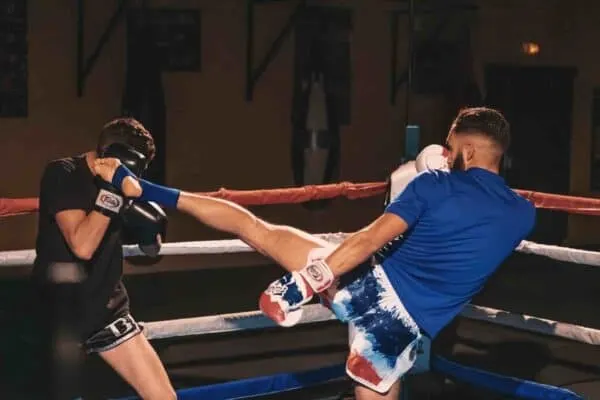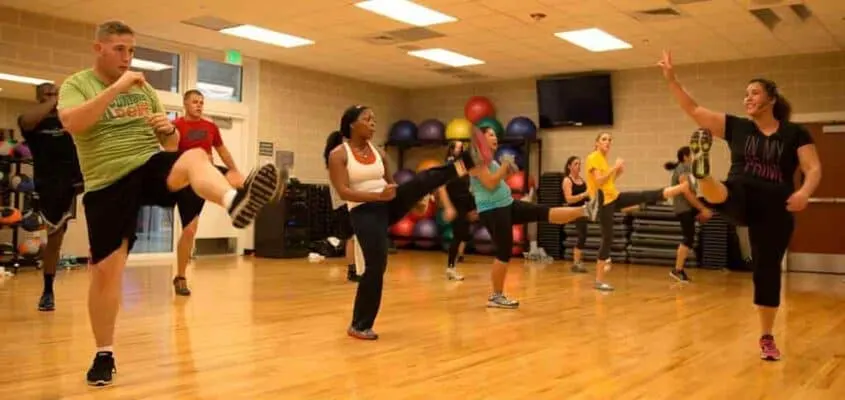
Kickboxing is practiced by millions of people all around the world, and it is one of the most popular martial arts. It meets the demands of just about every age group and people with different goals. It is a great option if you want to lose weight, improve muscle strength, or maybe switch over to MMA later. But, what about real fighting? Is kickboxing effective for self-defense?
Kickboxing is a very effective self-defense system because the training simulates a real fight with the emphasis being on learning how to apply striking techniques in real life. With kickboxing, your mind and body will be conditioned to handle a real-life threat with an effective response.
With that, bear in mind that kickboxing training is hard on your body and carries a quite high risk of injuries. The term “kickboxing” is loosely used to refer to all martial arts that mix kicks with punches (Muay Thai, Savate, and Lethwei). But kickboxing, in its original form, was developed in the 1950s, which is the form we are going to focus on in this article.
Is kickboxing good for self-defense?
Yes, kickboxing is great for self-defense as it trains both your mind and body for intense fighting. Here is a list of some of the key reasons why kickboxing is so effective:
Works well at all ranges
No matter if it’s a fight in the bar at close range, or you have to defend in the open space, kickboxing covers all ranges. Students learn how to keep their range using long-range kicks and punches, and of course, footwork.
At close range, it trains you to strike with fast and accurate boxing combos, as well as some basic fighting inside the clinch with knees (K-1 style).
Includes practical and direct techniques
Kickboxing was created as a mix of karate and full contact Muay Thai rules. As a result, you will learn how to throw different kicks with a lot of power, and how to mix those with western boxing combos. Each technique or move is designed to work in real combat against a person who is putting on real resistance and trying to fight back and hurt you. All of the moves are simple and not that hard to learn, but require a bit of athleticism and time to get them right.
| Punches | Kicks | Knees |
| Jab | Roundhouse kick | Straight knee |
| Hook | Front Kick | Curving knee |
| Uppercut | Side Kick | Diagonal Knee |
| Cross | Spinning kick | Flying knee |
Realistic methods of training
The concept and methods of training are in line with the type of fighting you may encounter on the streets. After around 6 months of training, most students start doing live drills and sparring. This is a method of training where the goal is to simulate a real fight with the emphasis being on learning how to apply techniques in real life. This helps students develop good timing, reactions, and feeling for distance. But psychological benefits are even better.
Initial sparring sessions might feel scary and your mind will probably go into panic mode after the first punch. But over time, and as you improve muscle memory, your mind and body will learn how to absorb damage and stay calm as the fists are flying. This is crucial because staying calm in a fight is the only way you can make rational decisions and apply techniques that you learned in training. It is often said that the one who stays calm in a street fight is usually the one who wins in the end.
Relatively easy to learn
Though it visually looks brutal and hard to learn, kickboxing is actually not that hard to master. It all revolves around 5–6 different punches, the same number of kicks, and how to put it all together and mix it with footwork. Most of the techniques are direct and easy to learn, but on the other side, take a bit of time to master to perfection. At first, it’s all going to feel hard and awkward. But it is all going to become much easier as you get more flexible and improve your fitness.
The Pros and Cons of Kickboxing
Training in kickboxing has a lot of physical and mental benefits as well as a couple of downsides. Here is a detailed look at the pros and cons of kickboxing training:
The Pros of Kickboxing
Practical in real combat
As discussed above, kickboxing is among the most practical systems when it comes to self-defense. The entire concept and methods of teaching are oriented toward real combat. Even if you get into training just to get in shape, you will still develop valuable fighting skills, which is good because you never know when you are going to need them.
Burns a lot of calories
Kickboxing classes are cardio-intense and throwing hundreds of kicks and punches and doing all other cardio-intense exercises burns a lot of calories. In fact, one study has shown that you can burn up to 900 calories per hour of training, which is a lot. With a bit of consistency, you may lose weight and get your body in top shape in a very short time span.
Full body workout
Kickboxing is a mix of aerobic and anaerobic exercises that will activate every single muscle in your body. In each class, students engage upper and lower body muscles through exercises like:
- sprints or long runs
- hundreds of kicks and punches
- body weight exercises like pushups, squats, sit-ups
- exercises that improve core muscles
- stretching before and after each session
You won’t develop big muscles as you would in a gym by lifting heavy weights. But, you will develop functional strength, tone your body and trim your waist.
Improves flexibility, coordination, and balance
Most kickboxing techniques require a lot of flexibility and core strength to perform the right way. This is the main reason why students stretch before and after each class, and do various exercises that target the core muscles. Over time, this will improve your balance, reflexes, and coordination.
Reduces stress and improves mental health
Punching and kicking the hell out of the heavy bag after a long day is a great way to relieve stress. In fact, engaging in intense physical activity releases various “happy” hormones in your mind like dopamine and serotonin, which lifts your mood up and improves mental health in the long run.
The Cons of Kickboxing
- Quite one-dimensional – as it focuses only on mixing kicks with punches. There is no grappling and you won’t learn how to fight on the ground or defend against takedowns or submissions.
- No dirty tactics– is a major downside when it comes to self-defense as you won’t learn how to defend or apply dirty moves. Though brutal, dirty moves are highly effective in street fighting where there are no rules.
- The high injury rate– is also a problem as the injury rate sits at around 40 for every 1,000 minutes. But this also depends on the gym you train in, and whether you are professional or amateur.
What are the different styles of kickboxing?
Kickboxing as a martial art on its own has different styles that are actually defined by the different sets of rules. Bear in mind that the overall effectiveness of the system does not vary much between the following styles.

K-1
K-1 is, perhaps, the most popular style in modern times. In the initial form, K-1 was a kickboxing organization founded in 1993. But over time, the official K-1 rules got so popular, so much that they became an official style of kickboxing. These rules enable athletes to strike with kicks, and punches, as well as with knees inside the clinch (limited time). It is a very brutal style where the emphasis is on power and inflicting as much damage as possible with each strike.
Dutch style
Is another famous style developed in the 1960s in the Netherlands by a man called Jan Plas. Dutch style is unique because, in contrast with most other styles, puts more emphasis on punches. The focus is on advanced western boxing combos, footwork, and landing fast and precise low kicks. Fighters trained in this style would often throw a barrage of punches, before closing the combo with a hard low/high kick.
American Kickboxing
American kickboxing, which is now internationally recognized as “Full Contact Kickboxing,” was developed in the 1970s, and it differs a lot from other styles because it doesn’t include low kicks. The focus is on punches and mixing those with high kicks. The only major downside of this style is the fact that you might have a hard time finding an American Kickboxing gym outside the US.
Japanese kickboxing
This is the original style of modern kickboxing developed as a mix of kyokushin karate techniques and Muay Thai full contact rules. Japanese kickboxing emerged in the 1950s and the original founders were Tatsuo Yamada and a boxing promoter, Osamu Noguchi.
Interested in learning more? Here’s an article we think you’ll like: What are the Different Styles of Kickboxing? Simply Explained
Is kickboxing good for MMA?
Yes, kickboxing stands for a solid MMA base on top of which you can later add other skills and weapons. Over the course of MMA history, it has been proven that Muay Thai is the most effective style when it comes to striking. But, modern kickboxing, notably the Dutch style, does not fall behind that much.

The Dutch style is not as versatile as Muay Thai when it comes to weapons. It is quite limited actually as it doesn’t include elbow and knee striking, as well as fighting inside the clinch. Last but not least, it also won’t teach you how to throw the opponent down from the clinch. But, there are areas where the Dutch style excels and is even better than Thai boxing.
First, the Dutch style is more technical and far more advanced when it comes to punches. Fighters trained in this style also do a much better job of moving their heads off the centerline and mixing in footwork to create angles and keep their range. On top of that, top-level Dutch-style kickboxers do not need much time to develop a strong clinch game as they already have a strong base.
The best thing about kickboxing in MMA is the fact that it goes well with other styles. If you look at the top-level UFC fighters, for instance, most of them have had an elite kickboxing game.
Does Cardio Kickboxing Teach Self-Defense?
Cardio kickboxing is a great full-body workout but apart from a basic understanding of how to perform basic kickboxing techniques, it won’t teach you much else in terms of real fighting. In recent years, this form has become very popular among people, notably women, who want to lose weight, improve muscle strength, build strong endurance, and of course, socialize. However, do not sign up for cardio kickboxing classes thinking that you are going to learn how to fight in real life and here is why.

Cardio kickboxing is a mix of high-intensity cardio workouts and martial arts moves. It provides you with some basic understanding of how to stand in a proper stance, throw kicks, and punches. However, the focus is not on developing perfect techniques, reflexes or learning how to apply these moves in a real fight. No, the main goal is to burn calories and fat, lose weight and get in top shape.
As a result, there is no sparring in cardio kickboxing or doing live drills where two students are exchanging punches and kicks and simulating real attacks. This, on one side, makes training safe and free from injuries. But on the other, you can’t expect to develop crucial fighting skills without sparring. So, is cardio kickboxing for you?
The answer truly depends on what you want to achieve. If your goal is to improve your fitness and get a good workout, then go for it. But if you want to learn how to fight, then you should search for a proper kickboxing gym.
Kickboxing vs. Boxing – Which one is better for self-defense?
On paper, kickboxing is a more versatile system and with that, works better in street fighting than boxing. However, despite its limitations in terms of weapons, boxing is very practical in self-defense scenarios. The only fair answer is that both kickboxing and boxing are equally effective in this aspect. Both will:
- Train your mind to stay calm when your life is in danger
- Teach how to make rational decisions in a fight and apply techniques
- Help develop good reactions, timing, and proper technique
- Train how to neutralize the opponent in the most efficient way possible
Kickboxing has an edge if the fight is in the open space where you can utilize long-range kicks to destroy the attacker. Most people not trained in martial arts do not have the ability to absorb more than one kick to the body or leg, not to mention what would happen if your shin lands on the side of their head.
Boxing is a better option if the fight is at close range and in a closed space. The explosive and precise combos that you learn are ideal for this type of situation.
Which is better kickboxing or taekwondo?
Kickboxing is better simply because training is more oriented towards real combat. Each kickboxing gym includes a lot of full-contact sparring and the rules are more in line with freestyle fighting on the streets. Modern Taekwondo practice focuses too much on forms and preparing you to compete under the point fighting rules which has a negative impact on the overall effectiveness of the art.
For example, there is no dynamic action in a Taekwondo match. According to rules, the match resets each time an athlete lands a clean strike, which is not how fighting works on the streets. Next, the emphasis is on light contact, speed, and precision and you are not supposed to throw strikes with full power. Last but not least, there are no punches to the head as athletes are only allowed to land punches in the upper body area below the neck.
The techniques you learn, timing, and automatic reactions that you develop in kickboxing are superior to Taekwondo in every way.
RECOMMENDED READING: Taekwondo vs Kickboxing – Key Differences and Comparison
Does kickboxing teach you how to punch?
Yes, as its name suggests, kickboxing is a mix of kicking and punching. In fact, modern kickboxing practice puts a lot of emphasis on hand strikes, even more than on kicks. You will learn advanced boxing combos, how to mix hand strikes with footwork, blocks, and of course, kicks.
If you want to develop good boxing skills, then the Dutch Style is the one you should look for. It is a very technical style that puts a lot of focus on advanced boxing combos, and lethal low kicks. You will learn all about using punches, angles, and head movement, to create openings and do damage. On top of that, you will learn how to mix these skills with fast and powerful kicks, and flashy moves like spinning back fists.
